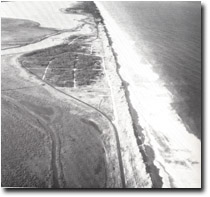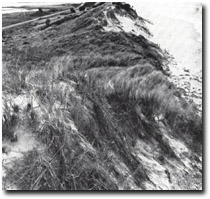GL35 (8321) Outer Barrier near Seaspray
|
This information has been developed from the publications:
|
| Location: | 190547 (8321). Three kilometres north-east of Seaspray. |  Seaspray. High grassy foredune of outer barrier. |
Abstract: | Outer barrier ridge; Lake Reeve; marginal bluff. | |
Access: | Seaspray - Golden Beach Road; Seaspray - Sale Road. | |
Ownership: | Crown land at the cost, private land elsewhere. | |
Geomorphology:  Seaspray. High grassy foredune of outer barrier. | For approximately five kilometres north-east of Seaspray, the outer barrier is a single, high (5-8 metres) sand ridge usually steeply cliffed on the seaward edge. Unlike most other sections of the outer barrier in the study area, this section is vegetated only by dune grasses, dominantly Ammophila and Spinifex, and seems at no stage to have carried an Acacia or Leptospermum scrub. The dunes are therefore very young and it is probably that most of the vertical growth of this section of the barrier has taken place since the introduction and spread of Ammophila over the last 100 years. | |
This area may therefore have been the site of more frequent and more recent washovers into Lake Reeve then in areas to the north-east, hence the lake may have a longer salinity history than the other lakes. This may account for the much greater diversity of salt marshes along the south-western margins of Lake Reeve compared with the monotonous Juncus sedge land or Salicornia quinqueflora herb field that is characteristic of most other saline swamps in the Gippsland Lakes. | ||
Included in the lake floor sediment of Lake Reeve are marine shell beds which are exposed in drainage ditches near Seaspray. Radiocarbon dating of these, indicating a late Holocene age, has been used as evidence of a higher sea level during late Holocene times (approximately 3,000 years BP), although the evidence is equivocal. The marginal bluff is well defined where it crosses the Sale Road near Seaspray and clearly delineates the inner margin of the Lake Reeve wetlands for several kilometres to the north-east. | ||
Significance: | State. The single high and grassy outer barrier ridge is unique in the Gippsland Lakes region. It illustrates further the physiographic changes accompanying the introduction of Amophila (compare with Site 8822 - 3). | |
Management: | Continued control of pedestrian access across the barrier is necessary to contain the rapid extension of blowouts. Extensive drainage of Lake Reeve is not compatible with maintaining the more diverse salt marsh communities. | |
References: | Jenkin, J.J. (1968). "The geomorphology and Upper Cainozoic geology of Southeast Gippsland, Victoria". Geol. Surv. Vict. Memoir 27. Gill, E.D. (1971). "Applications of radiocarbon dating in Victoria, Australia". Proc. R. Soc. Vict., 84 (21) : 71-86. | |
 Sites GL34-35 |


